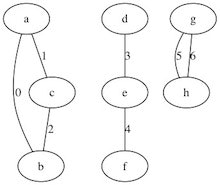こんにちは。
Boost Graph Library の depth_first_visit を利用し、サブグラフ(連結グラフ)を処理してみました。Graph traversal を行い、与えた始点から辿ることができるエッジを列挙しています1 2。下記例で、始点 a b h を与え、エッジ 0 1 2 5 6 を得ました。エッジ 3 4 は辿られません。

$ g++ -std=c++11 -I/usr/local/include dfs_visit.cpp
$ ./a.out
number of (nodes, edges) in a graph = (8, 7)
starting nodes: a b h
visited edges: 0 1 2 5 6
dfs_visit.cpp
#include <vector>
#include <iostream>
#include <boost/range/adaptor/indexed.hpp>
#include <boost/graph/adjacency_list.hpp>
#include <boost/graph/depth_first_search.hpp>
struct VertexProperty {
std::string label;
};
typedef boost::adjacency_list<boost::vecS, boost::vecS, boost::undirectedS, VertexProperty, int64_t> graph_t;
typedef graph_t::vertex_descriptor vertex_t;
struct edge {
int F, T; // vertices
};
enum { a, b, c, d, e, f, g, h }; // labels
graph_t make_graph() {
graph_t graph;
std::vector<std::string> labels = { "a", "b", "c", "d", "e", "f", "g", "h"};
std::vector<edge> edges = {
{a, b},
{a, c},
{c, b},
{d, e},
{e, f},
{g, h},
{g, h}
};
for(auto&& it : edges | boost::adaptors::indexed()){
edge e = it.value();
add_edge(e.F, e.T, it.index(), graph);
}
for (int i = 0; i < num_vertices(graph); i++) {
graph[i].label = labels[i];
}
return graph;
}
class MyVisitor : public boost::default_dfs_visitor
{
public:
MyVisitor(std::vector<bool>& connectedEdges)
: edges_(connectedEdges) {}
void initialize_vertex(vertex_t v, const graph_t& g) const {}
void examine_edge(const graph_t::edge_descriptor &e, const graph_t &g) const {
edges_[g[e]] = true;
}
private:
std::vector<bool>& edges_;
};
void print_edges(graph_t graph, std::vector<vertex_t> nodes, std::vector<bool> edges) {
std::cout << "starting nodes: ";
for (const auto& u : nodes) {
std::cout << graph[u].label << " ";
}
std::cout << '\n';
std::cout << "visited edges: ";
for(auto&& it : edges | boost::adaptors::indexed()){
if (it.value()) {
std::cout << it.index() << " ";
}
}
std::cout << '\n';
}
void visit_edges(graph_t graph) {
std::vector<vertex_t> nodes = {a, b, h};
std::vector<bool> edges(boost::num_edges(graph));
MyVisitor vis(edges);
auto indexmap = boost::get(boost::vertex_index, graph);
auto colormap = boost::make_vector_property_map<boost::default_color_type>(indexmap);
for (const auto& u : boost::make_iterator_range(vertices(graph))) {
colormap[u] = boost::white_color;
vis.initialize_vertex(u, graph);
}
for (const auto& u : nodes) {
if (colormap[u] == boost::white_color) {
boost::depth_first_visit(graph, u, vis, colormap);
}
}
print_edges(graph, nodes, edges);
}
int main() {
graph_t graph = make_graph();
std::cout << "number of (nodes, edges) in a graph = (" << boost::num_vertices(graph);
std::cout << ", " << boost::num_edges(graph) << ")\n";
print_graph(graph);
visit_edges(graph);
}
-
なお depth_first_search の方を利用すると、与えた始点から辿ることができない頂点・エッジに関わらず、辿ります(Graph traversal)。 ↩
-
なお Go で同等なことを行ったのはこちら:「グラフの連結成分(エッジを列挙)」。 ↩